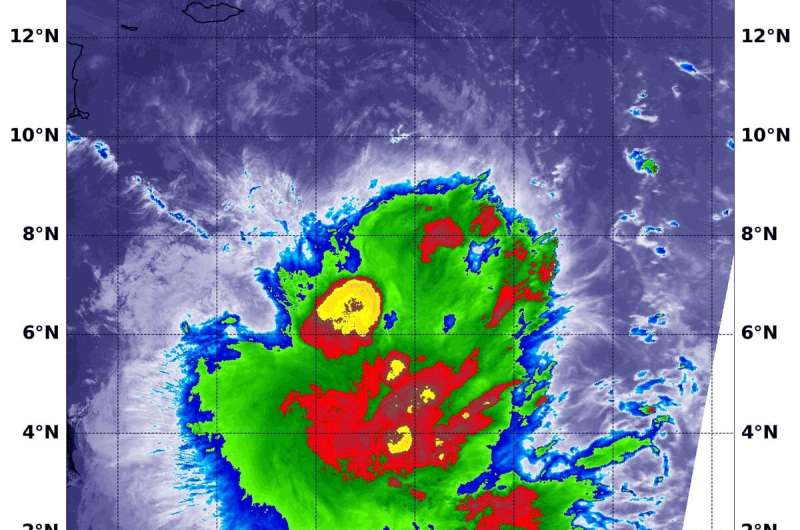NASA sees Tropical Storm 06A maintaining strength

NASA's Aqua satellite found some powerful storms in Tropical Storm 06A as it moved through the Arabian Sea toward Somalia.
NASA's Aqua satellite used infrared light to analyze the strength of storms in 06A and found it was maintaining strength. Infrared data provides temperature information, and the strongest thunderstorms that reach high into the atmosphere have the coldest cloud top temperatures.
On Dec. 4 at 4:55 a.m. EST (0955 UTC), the Moderate Resolution Imaging Spectroradiometer or MODIS instrument aboard NASA's Aqua satellite gathered temperature information about Tropical Storm 06A's cloud tops. MODIS found several small areas of powerful thunderstorms where temperatures were as cold as or colder than minus 80 degrees Fahrenheit (minus 62.2 degrees Celsius), embedded in a much larger area of slightly warmer cloud tops of minus 70 degrees Fahrenheit (minus 56.6 Celsius). Cloud top temperatures that cold indicate strong storms with the potential to generate heavy rainfall.
On Dec. 4 at 10 a.m., EST (1500 UTC), Tropical Storm 06A was located near latitude 8.4 degrees north and longitude 57.0 degrees east in the Arabian Sea, Northern Indian Ocean. That is about 864 nautical miles east-southeast of Djibouti. Djibouti is a sovereign state in the Horn of Africa with a coastline on the Gulf of Aden. It is bordered by Somalia to the south, Ethiopia to the west, and Etriea to the north. 06A was moving to the northwest and had maximum sustained winds near 35 knots (40 mph/65 kph).
The Joint Typhoon Warning Center or JTWC noted, "The storm's good outflow (air that flows outwards from a storm system) and warm sea surface temperatures are being offset by strong (20-25 knots/23-29 mph/37-46 kph) vertical wind shear to make the environment marginally supportive. Tropical Storm 06A appeared to accelerate west-northwestward over the past six hours, suggesting a subtropical ridge (an elongated area of high pressure) to the north has become the primary steering mechanism." Over the next 24 hours, the subtropical ridge will cause 06A to turn onto a west southwestward track and remain there until making landfall and dissipating.
Tropical Storm 06A is expected to make landfall in east central Somalia late on Dec. 6.
Tropical cyclones and hurricanes are the most powerful weather events on Earth. NASA's expertise in space and scientific exploration contributes to essential services provided to the American people by other federal agencies, such as hurricane weather forecasting.
Provided by NASA's Goddard Space Flight Center





















